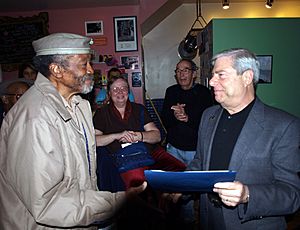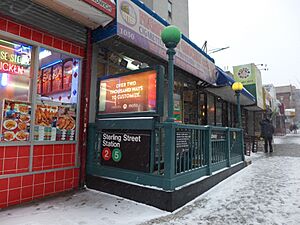Prospect Lefferts Gardens facts for kids
Quick facts for kids
Prospect Lefferts Gardens
|
|
|---|---|
|
Neighborhood of Brooklyn
|
|

Northeast view from top of Patio Gardens
|
|
| Country | |
| State | |
| City | |
| Borough | |
| Community District | Brooklyn 9 |
| Area | |
| • Total | 3.67 km2 (1.418 sq mi) |
| Population
(2015)
|
|
| • Total | 99,287 |
| • Density | 27,035/km2 (70,019/sq mi) |
| Ethnicity | |
| • Black | 76.5% |
| • Hispanic | 9.8 |
| • White | 9.7 |
| • Asian | 1.6 |
| • Others | 2.4 |
| Economics | |
| • Median income | $39,319 |
| ZIP Codes |
11225
|
| Area code | 718, 347, 929, and 917 |
Prospect Lefferts Gardens is a neighborhood in the Flatbush area of Brooklyn, New York City. It is a mostly residential area.
The neighborhood is surrounded by Empire Boulevard to the north, Clarkson Avenue to the south, New York Avenue to the east, and Ocean Avenue/Prospect Park to the west. In 1979, a part of the neighborhood became a special historic area. It is called the Prospect Lefferts Gardens Historic District.
Prospect Lefferts Gardens has many different cultures. Many people living here are from the West Indies or are African-American. Since the 2000s, the neighborhood has been changing. More new residents have moved in, and new buildings are being built.
This area is part of Brooklyn Community Board 9. Its main ZIP Code is 11225. The New York City Police Department's 71st Precinct patrols the neighborhood.
Contents
About the Name
The name Prospect Lefferts Gardens was created in 1968. It was chosen by the Prospect Lefferts Gardens Neighborhood Association (PLGNA).
The name combines three nearby places:
- Prospect Park
- Lefferts Manor
- The Brooklyn Botanic Garden
Lefferts Manor is named after a Dutch family. They were early settlers in the area.
Neighborhood History
The area was first settled by a Dutch family in 1665. At that time, it was part of the Town of Flatbush.
In 1893, James Lefferts divided his family's land into 600 building lots. This area is now known as Lefferts Manor. He sold these lots to people who wanted to build homes. Lefferts wanted to make sure that only large, strong homes were built. So, he added special rules to the land deeds. These rules said that each lot must have a single-family home. It had to be made of brick or stone and be at least two stories tall. These rules still exist in Lefferts Manor today.
Most houses in Lefferts Manor were built between the late 1800s and early 1900s. The last ones were finished in the early 1950s. Patio Gardens, a large apartment complex, was built in the early 1960s.
Historic Districts
Lefferts Manor and some nearby streets became a landmark area in 1979. This was done by the New York City Landmarks Preservation Commission. The Lefferts Manor Historic District was added to the National Register of Historic Places in 1992.
In 2009, a second landmark area was created. It is called the Ocean on the Park Historic District. This small area has 12 unique townhouses. They look very different from the large apartment buildings nearby.
A third historic district, Chester Court, was named in 2014. It is a small street with 18 Tudor-style townhouses.
As Lefferts Manor grew, so did the surrounding area. Many one- and two-family homes were built in the early 1900s. Today, other parts of Prospect Lefferts Gardens have a mix of homes. There are single-family houses, multi-family homes, and larger apartment buildings.
Since the 1960s, many people from the Caribbean have moved here. They have also settled in nearby areas like East Flatbush and Crown Heights. These areas are sometimes called Little Caribbean on maps.
Community Groups
Prospect Lefferts Gardens has many active community groups. These groups help improve the neighborhood.
- PLG Arts started in 2009. They turn plain construction walls into colorful murals. These murals show local art and artists.
- LinRoFORMA, founded in 2010, helps residents and businesses on Lincoln Road. They work to make the street and neighborhood better.
- PLG Community Supported Agriculture connects the community with a farm in Connecticut. This group brings fresh, organic vegetables to residents.
- The Lefferts Community Food Cooperative opened in 2009. It is a market that sells healthy and responsible food.
- The Maple Street Community Garden started in 2012. It is a shared organic vegetable garden open to everyone. It also has a composting program.
- The Lefferts Manor Association was founded in 1919. It helps make sure the original building rules are followed.
- The Prospect Lefferts Gardens Neighborhood Association (PLGNA) was founded in 1968.
Population and People
In 2010, the population of Prospect Lefferts Gardens was about 67,459 people. Most residents are African American (76.5%). Other groups include Hispanic (9.8%) and White (9.6%).
The average life expectancy in this area is about 81.2 years. This is similar to the average for all of New York City. Many residents are middle-aged adults and young people. About 22% are under 18, and 30% are between 25 and 44 years old.
In 2016, the average household income was about $51,072. About 22% of residents live in poverty. This is similar to the rest of Brooklyn and New York City.
Fire Safety
The New York City Fire Department (FDNY) has two fire stations in Prospect Lefferts Gardens.
- Engine Co. 281/Ladder Co. 147 is at 1210 Cortelyou Road.
- Engine Co. 249/Ladder Co. 113 is at 491 Rogers Avenue.
Health in the Community
The air quality in Prospect Lefferts Gardens is generally good. About 8% of residents are smokers, which is lower than the city average.
Some health concerns in the area include obesity (32% of adults) and high blood pressure (37% of adults). About 19% of children are obese.
Most residents (81%) eat some fruits and vegetables every day. In 2018, 84% of residents said their health was "good" or "excellent." This is higher than the city's average.
Education
Prospect Lefferts Gardens has a good number of college-educated residents. About 35% of adults (age 25 and older) have a college degree or higher.
Reading and math skills in elementary schools have improved over the years. In 2011, 37% of students met reading goals, up from 31% in 2000. Math achievement rose from 21% to 47% in the same period.
However, more elementary school students miss many days of school here. About 22% of students miss 20 or more days a year. The city average is 20%. For high school students, about 77% graduate on time. This is slightly higher than the city average of 75%.
Local Schools
There are four public schools in the area, part of NYC School District 17:
- M.S. 002 is a middle school for grades six to eight.
- M.S. 61 serves grades six through nine.
- P.S. 92 is an elementary school for kindergarten through fifth grade.
- The Lefferts Gardens Charter School opened in 2010. It focuses on environmental science and hands-on learning for elementary students.
Public Library
The Brooklyn Public Library has a branch nearby. The Crown Heights branch is located at 560 New York Avenue.
Politics and Government
The neighborhood is part of New York's 9th congressional district. This district is represented by Democrat Yvette Clarke.
It is also served by:
- The 20th and 21st State Senate districts.
- The 42nd and 43rd State Assembly districts.
- The 35th and 40th City Council districts.
Prospect Lefferts Gardens is part of Brooklyn Community Board 9. This board helps local residents have a say in city decisions.
Getting Around
Prospect Lefferts Gardens has good public transportation.
- The New York City Subway serves the area. You can use the B, Q, and S train and Q train trains at the Prospect Park and Parkside Avenue stations. The 2 and 5 train train stops at Sterling Street and Winthrop Street stations.
- Several New York City Bus routes also serve the neighborhood. These include the B12, B16, B41, B43, B44, B44 SBS, B48, B49 buses.
See also
 In Spanish: Prospect-Lefferts Gardens (Brooklyn) para niños
In Spanish: Prospect-Lefferts Gardens (Brooklyn) para niños




